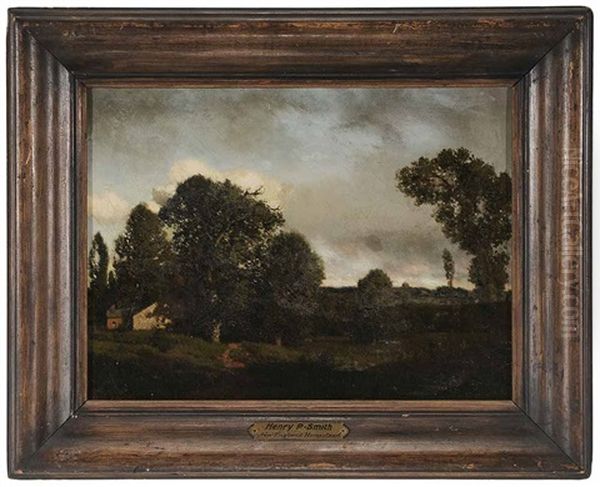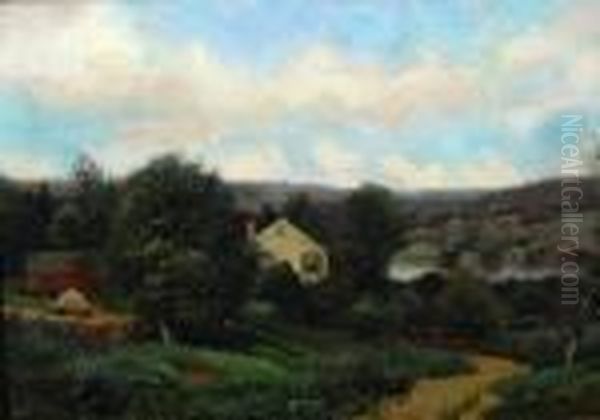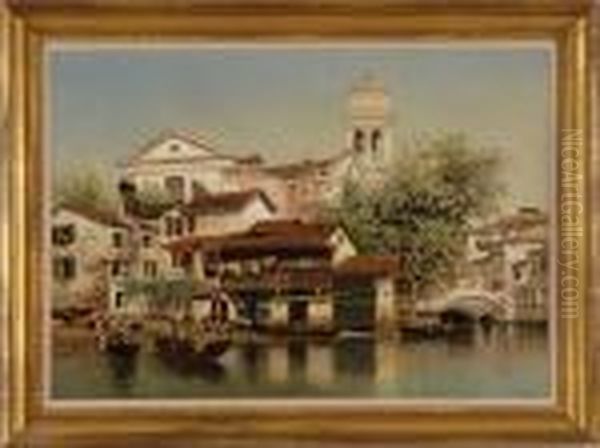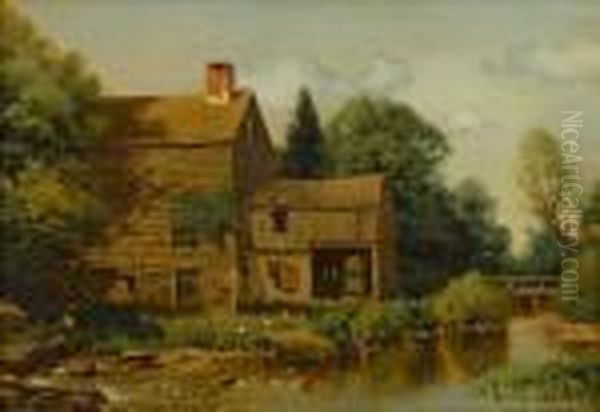Henry Pember Smith (1854-1907) was a significant American landscape painter whose career flourished during the late nineteenth and early twentieth centuries. He is best remembered for his meticulously rendered and often tranquil depictions of rural New England homes and the picturesque canals and architecture of Venice. His work captured a sense of nostalgia and serene beauty that resonated deeply with audiences during a period of rapid industrialization and urbanization in America. Smith carved a distinct niche for himself, blending elements of realism with an idealized vision of nature and domesticity.
Early Life and Artistic Formation
Born in Waterford, Connecticut, in 1854, Henry Pember Smith entered the world during a dynamic era in American art. The Hudson River School's influence was still palpable, celebrating the grandeur of the American wilderness, while new European trends were beginning to make their way across the Atlantic. Details about Smith's formal artistic training are scarce, leading many historians to believe he was largely self-taught. This was not uncommon for artists of his time, many of whom learned by copying existing works, studying nature directly, and observing the techniques of established painters.
It is likely that Smith honed his skills through dedicated practice and close observation of the natural world around him, particularly the coastal landscapes and colonial architecture of his native New England. He developed a keen eye for detail and a remarkable ability to capture the effects of light and atmosphere, qualities that would become hallmarks of his mature style. By the late 1870s, he had established himself as a professional artist, setting up a studio in New York City, which was rapidly becoming the center of the American art world.
Artistic Style and Dominant Themes

Henry Pember Smith's style is characterized by its detailed realism, careful draftsmanship, and sensitivity to light. While working after the main flourishing of the Hudson River School painters like Thomas Cole and Asher B. Durand, Smith inherited their commitment to representing the landscape faithfully. However, his focus shifted from the sublime wilderness favored by earlier artists to more intimate, domesticated scenes. His work often displays qualities associated with Luminism, particularly in its treatment of light and atmosphere, evoking a sense of stillness and tranquility, though he is not typically categorized strictly within that movement alongside figures like John F. Kensett or Martin Johnson Heade.
Smith's paintings often feature a warm, inviting light, bathing his subjects in a gentle glow, whether depicting the crisp air of an autumn afternoon in Connecticut or the hazy sunlight reflecting off a Venetian canal. His brushwork is typically precise and controlled, allowing for a high degree of detail in rendering architectural elements, foliage, and water reflections. This meticulous approach lent his works a near-photographic clarity, which appealed greatly to contemporary tastes.
Thematically, Smith concentrated on two primary areas: the rural landscapes of the American Northeast and the iconic cityscapes of Venice. His New England scenes frequently depict charming colonial-era houses nestled amidst lush gardens or alongside quiet streams and ponds. These paintings, often titled generically as "New England Homestead" or similar variations, evoke a sense of peace, stability, and connection to an idealized American past. They often feature autumnal settings, allowing Smith to explore a rich palette of reds, oranges, and golds in the foliage.
Venetian Views
Alongside his American subjects, Smith became equally renowned for his paintings of Venice. Like many artists of his generation, including James McNeill Whistler, John Singer Sargent, and Thomas Moran, Smith was captivated by the unique beauty and romantic allure of the Italian city. He traveled to Europe, likely in the 1880s, spending significant time in Venice, as well as visiting other picturesque locations in France (Brittany, Normandy) and England.
His Venetian paintings typically focus on the city's famous canals, bridges, and palazzi. He excelled at capturing the interplay of light, water, and architecture, rendering the intricate details of buildings and the shimmering reflections on the canal surfaces. Works such as "A Venetian Canal" or "Venetian Scene" showcase his ability to convey the distinctive atmosphere of Venice – sometimes bright and sunny, other times veiled in a soft haze. While perhaps less overtly atmospheric or impressionistic than Whistler's Venetian nocturnes, Smith's views are admired for their clarity, detail, and serene compositions. His approach followed the tradition of Venetian view painters like Canaletto and Francesco Guardi, updated with a nineteenth-century sensibility.
Travels and Influences

Smith's travels abroad were crucial to his artistic development. His time in Europe exposed him to different landscapes, artistic traditions, and perhaps contemporary art movements. While his style remained fundamentally rooted in American realism, his European experiences broadened his subject matter and likely reinforced his interest in capturing specific atmospheric conditions and light effects. His visits to Brittany and Normandy in France may have brought him into contact with the lingering influence of the Barbizon School, whose artists emphasized rural subjects and naturalistic representation, aligning with Smith's own inclinations. Painters like Jean-Baptiste-Camille Corot or Charles-François Daubigny championed direct observation and atmospheric rendering, which may have resonated with Smith.
His coastal scenes, painted both in Europe and along the American eastern seaboard (particularly Connecticut, Rhode Island, and New Jersey), show an affinity for the work of marine painters. He captured the gentle lapping of waves, the textures of sandy shores, and the clear light typical of coastal environments, sometimes compared to the work of artists like Alfred Thompson Bricher or William Trost Richards, who also specialized in detailed coastal views.
Exhibitions, Affiliations, and Recognition
Henry Pember Smith actively participated in the American art scene throughout his career. He regularly submitted his works to major exhibitions, ensuring his visibility among collectors, critics, and fellow artists. He exhibited frequently at the prestigious National Academy of Design in New York, although he never became a full Academician. His paintings were also shown at the Pennsylvania Academy of the Fine Arts in Philadelphia, the Boston Art Club, the Brooklyn Art Association (later the Brooklyn Museum), and the Art Institute of Chicago.
His participation in these exhibitions placed his work alongside that of the leading artists of the day, from the established figures of the late Hudson River School like Sanford Robinson Gifford and Albert Bierstadt to emerging Tonalists and American Impressionists. Smith was also a member of the American Watercolor Society, indicating his proficiency in that medium, and the Artists' Fund Society, an organization dedicated to supporting artists in need.
Smith achieved considerable commercial success during his lifetime. His idyllic and meticulously painted landscapes found a ready market among urban dwellers seeking refuge from the complexities of modern life. His works were appreciated for their technical skill, recognizable subject matter, and reassuringly tranquil mood. They represented a continuation of the American landscape tradition, adapted to the tastes of the Gilded Age.
Representative Works
While Henry Pember Smith produced a large body of work, many pieces share similar themes and titles, making it difficult to single out a few definitive masterpieces. However, his oeuvre is well represented by paintings bearing titles such as:

New England Homestead: Typically depicting a well-maintained colonial house, often white, set in a verdant landscape with trees, perhaps a garden or a body of water nearby. These works epitomize his idealized vision of rural American life.
Old Lyme: Indicating scenes painted in or around the famous Connecticut art colony, known for its picturesque landscapes that attracted many artists, including members of the American Impressionist movement like Childe Hassam and Willard Metcalf. Smith's works from this area maintain his characteristic detailed realism.
Venetian Canal Scene: Showcasing his skill in rendering the architecture and waterways of Venice, focusing on light, reflection, and intricate detail. These often feature gondolas, mooring poles, and recognizable Venetian palazzi.
The Old Smith Place, Niantic, Connecticut: A more specific title suggesting a personal connection or a well-known local landmark, painted with his usual attention to detail and atmosphere.
Coastal Scene, Rhode Island: Representing his work along the New England shoreline, capturing the specific light and features of the coast.
These titles reflect the core subjects that defined his career and appealed to his audience.
Place in American Art History
Henry Pember Smith occupies a specific place within the broader narrative of late nineteenth-century American art. He worked during a transitional period, bridging the gap between the waning influence of the Hudson River School and the rise of Tonalism and American Impressionism. While contemporaries like George Inness (in his later work), Alexander Helwig Wyant, and Dwight Tryon moved towards more subjective, moody, and atmospheric interpretations of the landscape (Tonalism), and others like John Henry Twachtman and Theodore Robinson embraced the brighter palette and broken brushwork of Impressionism, Smith largely adhered to a more objective, detailed realism.
His style can be seen as a continuation of the descriptive naturalism popular in the mid-nineteenth century, refined with a heightened sensitivity to light and atmosphere that perhaps reflects a subtle awareness of newer trends without fully adopting them. He did not engage in the dramatic compositions of Frederic Edwin Church or the overt allegories of Cole, nor did he dissolve form in light like the Impressionists. Instead, he offered meticulously crafted, easily accessible visions of serene beauty.

His influence can be seen in the work of artists who followed his popular style, such as George W. Drew, who also painted detailed landscapes, particularly Venetian scenes, clearly inspired by Smith's successful formula. Smith's enduring appeal lay in his ability to create paintings that were both highly realistic and gently idealized, offering viewers a comforting glimpse of picturesque locales, both domestic and foreign.
Legacy and Conclusion
Henry Pember Smith died relatively young, at the age of 53, in 1907 in Asbury Park, New Jersey, due to heart disease. By the time of his death, the artistic landscape was shifting rapidly towards Modernism, and the detailed realism he practiced began to fall out of critical favor. However, his paintings remained popular with collectors for many years.
In recent decades, there has been a renewed appreciation for nineteenth-century American realism and the various movements that flourished during that era. Henry Pember Smith's work is now recognized for its technical accomplishment and its reflection of the cultural values and aesthetic preferences of his time. His paintings offer valuable insights into the late nineteenth-century fascination with both the American rural past and the romantic allure of European travel destinations like Venice.
His works are held in the collections of numerous American museums, including the Metropolitan Museum of Art, the Smithsonian American Art Museum, the Brooklyn Museum, the New-York Historical Society, and the Florence Griswold Museum in Old Lyme, Connecticut. These collections preserve the legacy of an artist who, while perhaps not an innovator on the scale of some of his contemporaries, possessed a remarkable talent for capturing scenes of tranquil beauty with meticulous care and enduring appeal. Henry Pember Smith remains a significant figure for his consistent dedication to detailed landscape painting and his creation of idyllic images that continue to resonate with viewers today.